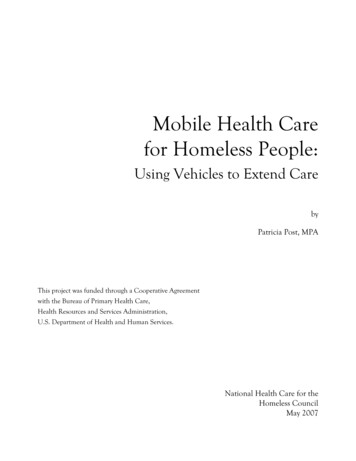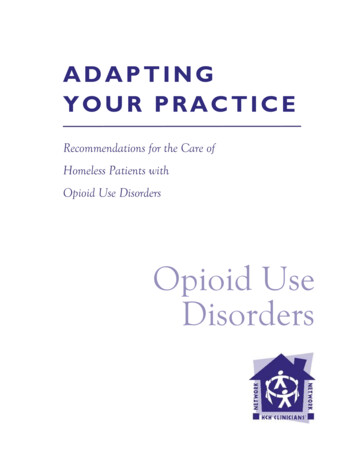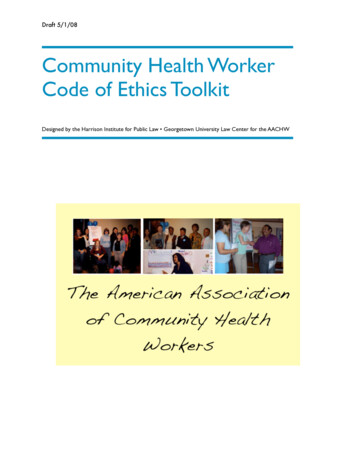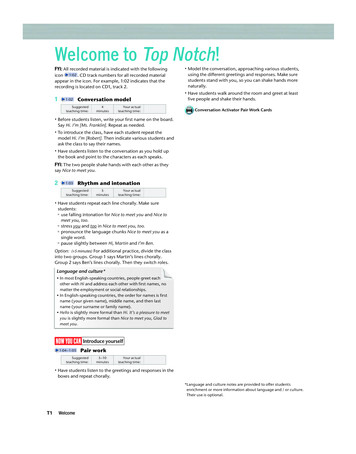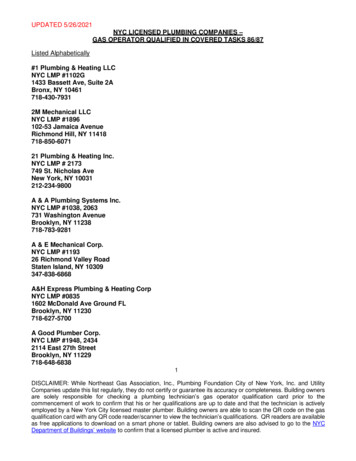![Welcome [nhchc ]](/img/28/nhchc-partnerpha.jpg)
Transcription
WelcomeHow to Partner with your Local Housing AuthorityWebinarDecember 13, 2011We will begin promptly @ 1PM ESTHostMelissa Da SilvaDeputy DirectorNational Health Care forthe Homeless CouncilThis publication was supported by Grant/Cooperative Agreement Number U30CS09746-04-00 from the Health Resources andServices Administration, Bureau of Primary Health Care (HRSA/BPHC). Its contents are solely the responsibility of the authorsand do not necessarily represent the official views of HRSA/BPHC.
How to Partnerwith your LocalHousingAuthorityHealth Care & Housing Are Human Rights
PresenterAlex Lehr OʼConnell, MPH, CPHDirectorCommunity Health Partners for Sustainability3
Introductionswww.chpfs.org4
Objectives for TodayParticipants will:1. Be able to identify access barriers thatpublic housing residents share withhomeless individuals.2. Be able to identify at least one benefit topartnership with a Housing Authority3. Better understand HRSAʼs Public HousingPrimary Care Program.5
Why Partner?Without partnershipOrganization 1Organization2Nebulousidea ofsocialchangeOrganization 3With partnershipStrengths ofOrganization 1LargerobjectiveStrengths ofOrganization2Strengths ofOrganization3Social change6
Why Partner? Align joint response to intertwined issuesof health and housing Marketing channel for vulnerablepopulation that is largely Medicaid eligible Access to funding opportunities (HUD) Access to Housing Authority resources(space, human resources)7
Public Housing Primary CareProgram Authorized by Section 330(i) Overseen by the HRSA BPHC Office ofSpecial Populations Health In 2010, Served 172,731 patients through50 reporting grantees Special populations waivers available insome cases8
ExamplesPublic Health ManagementCorporation and Resources forHuman DevelopmentFQHCs serving neighborhoods withdense public housing and facingdisparities in access and outcomes.Each provides comprehensive healthcare and health promotion on-site andthrough housing authority events.Philadelphia HousingAuthorityInitially provides space fornew health center start-ups,converting housing unit intoclinic space.Ongoing, provides outreachto bring in new patientsthrough public events,distribution of materials9
Recent Trends in Public Housing1. Greater demand2. New approaches in housing Decentralization Expanded eligibility3. New approaches in health care10
Recent Trend: Greater DemandThe Burden of Housing CostsIn 2007: More than 45% of all renters spent 30% or more of theirincome on housing, the benchmark level considered asevere cost burden. 51% of renters in the bottom income quartile spent morethan half their income on housing. 70% of renters in the bottom tenth of the incomedistribution spend more than half of their income onhousing.11
Recent Trend: Greater Demand No change in average waiting time forpublic and assisted housing despiteincrease of nearly 250,000 units.– 1996: 19 month wait, 4,814,983 units– 2008: 19 month wait, 5,063,071 units Waiting times in some areas exceed 10years.12
Recent Trend: New Approachesin Housing Increase in total units is from increases in Voucher programPublic Housing units actually decreased slightly13
Recent Trend: New Approachesin HousingHOPE 6 Program– Created by the Departments of VeteransAffairs and Housing and Urban Development,and Independent Agencies AppropriationsAct, 1993 (Pub.L. 102-389), approved onOctober 6, 1992.14
Recent Trend: New Approachesin HousingHOPE 6 Strategies Change the physical shape of public housing– Decreased reliance on high-rise, multi-unit developments– Increased reliance on duplexes/low-rise developments and scatteredsites Provide comprehensive services to promote residentself-sufficiency– Job training, health, benefits enrollment Lessen concentrations of poverty and promote mixedincome communities Forge partnerships to leverage support and resources15
Recent Trend: New Approachesin Housing Increased reliance on Section 8 (e.g., voucher)programs– Section 8-only programs are defined as assistedhousing, NOT public housing, and are NOT coveredunder Section 330i funding for FQHCs (unlessreceiving other, non-Section 8 funds under U.S.Public Housing Act of 1937). Increased reliance on scattered sites– When receiving non-Section 8 Public Housing Actfunds, ARE defined as public housing and AREcovered under Section 330i.16
Recent Trend: New Approachesin HousingMixed consequences of decentralization– Positives Increased economic capital through mixed-incomecommunities– Negatives Displacement of residents Outreach and community engagement morechallenged17
Recent Trend: New Approachesin HousingNew models and eligibility standards– The HEARTH ACT (http://www.hudhre.info/hearth/) Expands definition of homelessness to includeindividuals with insecure housing due to a varietyof factors HRSA definition of public housing remains thesame – only units owned/operated/improved by ahousing authority are considered “public” (notvoucher-only properties)18
Recent Trend: New Approachesin Health CareMany health centers serving public housingresidents are no longer located insidepublic housing– Collaboration with housing authority remainsimportant for community outreach/engagement19
Federal Expansions andOpportunities for PartnershipU.S. Department of Health and HumanServices New access points (FY2011 included bonus pointsfor public housing and other special populations) Capital improvements Service expansion funding Workforce development through National HealthService Corps and Bureau of Health Professions20
Federal Expansions andOpportunities for PartnershipU.S. Department of Housing and UrbanDevelopment– Encouraging partnership with housingauthorities– Can encourage policies within housingauthorities that promote health– Can encourage partnership with healthcenters through their grant programs21
Federal Expansions andOpportunities for PartnershipU.S. Department of Labor– Can encourage development of career tracks to fuelthe workforce at professional and paraprofessionallevels Providers of all sorts (doctors, nurse practitioners, physicianassistants) Enabling and behavioral health staff (LCSW, Psychologists) Administrative support staff (Medical Assistants, MedicalReceptionists) Outreach and health education (Promotoras, PatientNavigators)22
Opportunities for Partnership:HHS and HUD CollaborationIntent: Develop healthy, safe, productivecommunities Problem: Public housing residents face barriers to accessinghealth care, leading to poor health; Poor health leads todifficulties maintaining employment, stable homes andcompliance with housing regulations Strategy: Familiarize residents of public housing withexisting FQHC delivery sites and prepare communities tocompete for resources to develop FQHCs where there arenone currently. Outcome: Healthier residents are more able to be hold jobs,pay rent, be compliant with public housing requirements23
HUD Secretaryʼs Strategic PlanGoal 3: Utilize Housing as a Platform for Increasing theQuality of Life– Goal 3B: Utilize HUD assistance to improve healthoutcomes Strategy 1: Increase information about and access to healthservices, including veteransʼ health benefits, through partnershipswith health organizations and health care delivery systems Strategy 2: Increase coordination of HUD program with healthcareresources administered by other federal, state, and local programs Strategy 3: Provide physical space to collocate healthcare andwellness services with housing (for example, onsite health clinics) Strategy 4: Promote housing management practices that protectthe health of residents (for example, smoking cessation, pestmanagement, and green cleaning)24
Making the Case to a HousingAuthority: Key ContactsPartnerships must be explored early,through any or all of the following: Residents– Tenant Councils Housing Authority Staff– Executive Leadership– Development Staff– Outreach Staff– Site ManagersElected Officials25
Making the Case to a HousingAuthority: Return on InvestmentAccess to primary care and healthpromotion creates healthier residents whoare more able to: Give birth to low-risk, healthy weight babies Access immunizations, screenings, and otherpreventive services Manage their asthma and other chronic diseases,avoiding costly and time consuminghospitalizations and ER visits26
Making the Case to a HousingAuthority: Return on InvestmentHealthier residents are more able to: Access and keep decent jobs, including throughthe health center itself Pay rent on time and meet other public housingregulations Avoid school absences and successfully graduateon time Maintain safe households free of environmentalhazards and domestic violence Achieve a higher quality of life27
Making the Case to a HousingAuthority: Return on InvestmentResidents engaged in career tracks for health care jobs will earnmoreLevel of educationalattainmentMedian yearly earningsNo high school diploma 16,777High school diploma 24,435Associateʼs Degree 32,38628
Making the Case to a HousingAuthority: Return on InvestmentResidents engaged in career tracks for health care jobs willcontribute more in taxes, need less public supportEducation LevelLifetime IncomeLifetime Taxes andGovernmentBenefitsNo High SchoolDiploma 660,400( 32,000)GED 845,070 221,831High School Diploma 1,040,000 273,000AssociateʼsDegree 408,000 1,310,00029
Making the Case to a HousingAuthority: Return on InvestmentAs health centers that serve public housingexpand: Public housing residentsʼ access to servicesincreases Public housing residentsʼ health outcomesimprove Public housing residentsʼ self-sufficiencyincreases through employment in quality careers30
How May We Help You? Through staff and a national network ofconsultants, Community Health Partnersfor Sustainability provides: Live events Live and archived webinars and other web-hostedresources Site visits Needs assessments Document review Other topics as appropriate – just ask!31
Questions & AnswersAlex Lehr OʼConnell, MPH, CPHDirectorCommunity Health Partners for SustainabilityEmail: alex@chpfs.org Phone: (215) 731-7141Website: www.chpfs.org32
Resources National HCH Council website www.nhchc.orgDefining and Funding the Support in PermanentSupportive Housin rmanent-Supportive-Housing.pdfClinical Challenges in Permanent Supportive Housing http://www.nhchc.org/2011/10/publication/Other resources on PSH and Housing http://www.nhchc.org/resources/housing/Health Care & Housing Are Human Rights33
Thank you for your participation.Upon exiting you will be promptedto complete a short online survey.Please take a minute to completethe survey to evaluate this webinarproduction.
Services Administration, Bureau of Primary Health Care (HRSA/BPHC). Its contents are solely the responsibility of the authors . Providers of all sorts (doctors, nurse practitioners, physician assistants) Enabling and behavioral health staff (LCSW, Psychologists) . Healthier residents are more able to be hold jobs,

